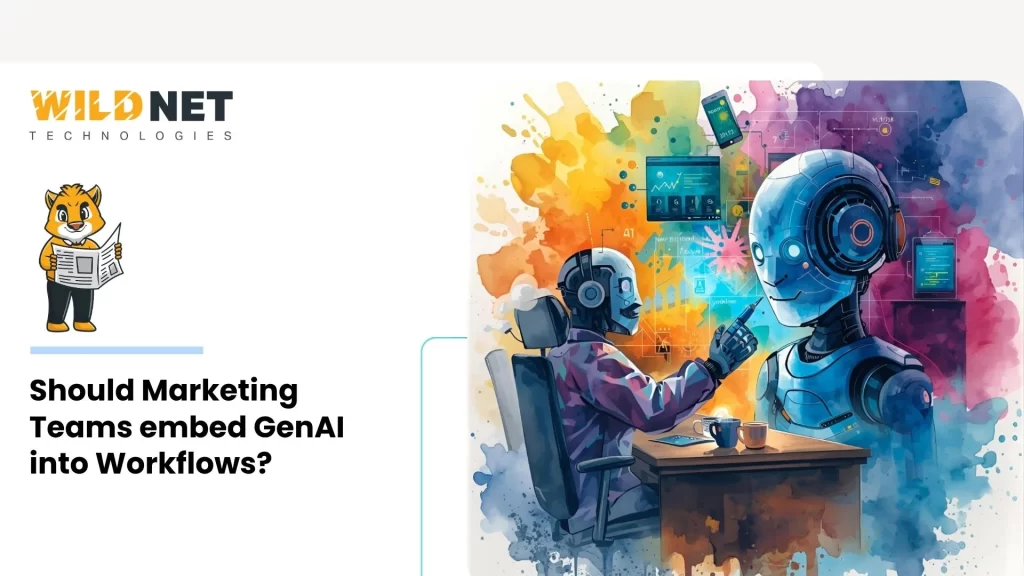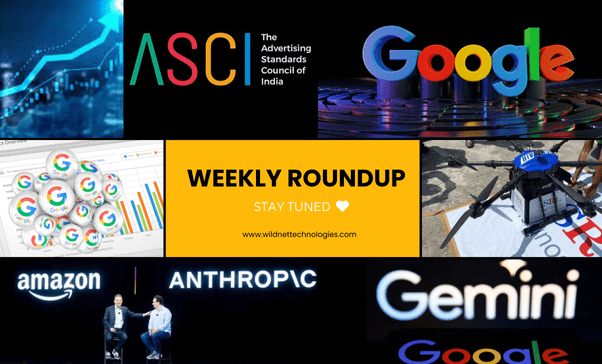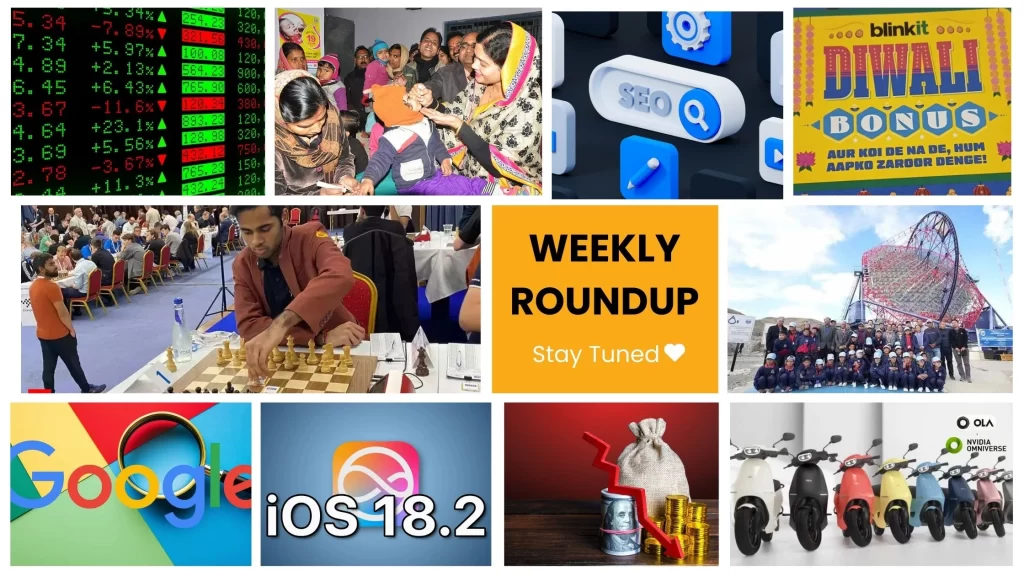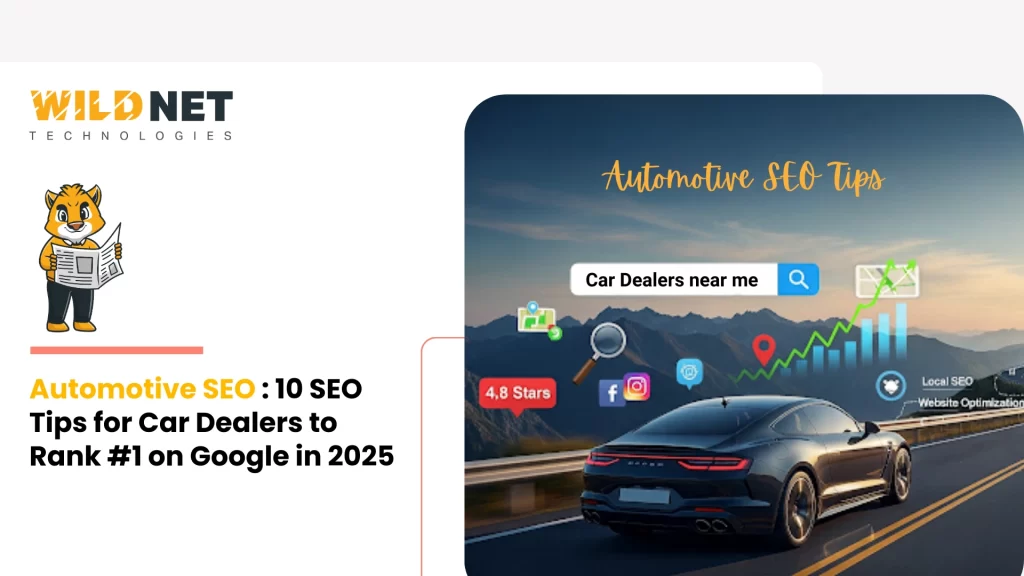Summary
Every brand uses AI in some form, but we are not here to tell you that. Wildnet’s latest newsletter offers the next step—or maybe two steps ahead.
Using one of the AIs isn’t going to cut it in 2026. The marketing teams are ready for the full AI package, i.e. GenAI workflows, the marketing assistant that can be leveraged for everything, be it content creation, visualization, auditing, reporting, and more.
Current AIs are yet to do it all while personalizing it, making this a golden chance for brands and marketers to learn the Human + AI synergy.
Key Takeaways
- Embedding GenAI workflows into marketing operations can unlock significant gains in speed, scale, and personalization.
- Effective adoption relies on redesigning workflows for GenAI workflow automation, not just inserting a tool.
- Choosing the right GenAI workflow tools is essential. They must integrate with the existing tech stack and support marketing goals.
- Moving toward a GenAI Agentic workflow – where AI agents execute or coordinate tasks – represents next-gen maturity.
- Governance, brand voice, team skills and measurement models must evolve for workflows to embed GenAI without compromise.
- The real question isn’t “Should we embed GenAI workflows?” but “How fast and how well can we do it?”
Table of Contents
⤷ What does it look like when Marketing Team Workflows embed GenAI?
Marketing teams today face an uncomfortable duality: They must craft ever-more personalized, context-aware content and campaigns while dealing with mounting pressure on speed, cost, and relevance.
Enter GenAI workflows. From drafting social posts and email copy to generating landing-page variations & automating campaign logic, the promise is clear. Yet many teams treat generative AI as an “add-on” instead of redesigning their workflows to embed GenAI in a repeatable & robust way.
When marketing teams embed GenAI workflows in their daily operations, they turn generative AI from a novelty into an accelerator of marketing performance. But to succeed, they must move beyond single-use tools to process redesign, cultural shifts, and integration-led thinking.
A few facts about GenAI Workflow
- As per an IBM study, 67% of CMOs (chief marketing officers) plan to implement GenAI workflows in 12 months and 87% in 24 months.
- GenAI usage in marketing is on the rise, whether it’s content creation by HubSpot Breeze, Visuals by OpenAI Sora, or Audience and ICP modelling via Persona by Delve.
- As per a McKinsey report, GenAI can contribute USD 4.4 trillion to the global productivity by focusing on sales and marketing domains.
- According to recent marketing news, GenAI workflows lead to 50% less time to market and 40% better ROI.
- AI Marketing is the need of the hour.
What is Gen AI, and Why embed GenAI workflows?
Generative AI (Gen AI) is a type of artificial intelligence that creates new content—like text, images, audio, or videos—based on patterns it has learned from existing data. It powers tools to write, design, or generate ideas, enabling faster and more creative outputs.
Gen AI is the best marketing buddy because it crafts personalized, data-driven content at scale, making campaigns faster, innovative, and engaging.
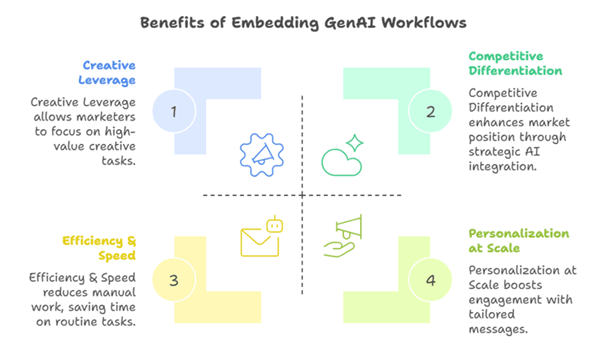
4 Benefits of Gen AI Workflows
And now let’s get to know the four major benefits that embedding GenAI workflows brings:
Efficiency & Speed
Generative AI can automate routine tasks — such as generating content variants or summarising data — so marketing teams can spend less time on manual work & more time on strategy.
Example
When teams embed GenAI workflows for content creation and personalization, they can launch campaigns in days, not weeks.
Personalization at Scale
With GenAI workflow automation, digital marketing teams can generate tailored messages for dozens or hundreds of segments, or even near-one-to-one experiences, something previously impossible for many organizations. This level of personalization can boost engagement and relevance.
Creative Leverage
When AI manages basic or repetitive tasks, human marketers can focus on higher-value work — strategy, creative direction, brand storytelling. This is one of the key promises of embedding GenAI workflows.
Competitive Differentiation
As GenAI workflow tools become more accessible, the differentiator becomes how well you embed those workflows into your marketing engine — not just using AI, but making it part of your daily rhythm.
In short, now that everyone is using or trying to use GenAI, your brand needs to do it smarter.
What does it look like when Marketing Team Workflows embed GenAI?
When marketing teams successfully embed GenAI workflows, you’ll observe:
Integrated Toolchains
The GenAI workflow tools are not an isolated silo but integrated with CMS, CRM and marketing automation platforms.
Automation of Repetitive Paths
GenAI workflow automation can automate workflow steps such as content variant generation, A/B testing prompts, and channel scheduling.
AI Agents performing Tasks
At the mature end of the curve, organizations move toward a GenAI Agentic workflow, where AI agents (or modules) take on full segments of the workflow—ideation, generation, optimization.
For example, a Reddit thread describes how marketers are exploring AI agents that “automate marketing workflows and repetitive tasks like audience segmentation, email drafting or campaign reporting.”
Human-in-the-loop Oversight
Embedding doesn’t mean excluding humans. Review, tone alignment, brand voice, and quality control remain critical & human-only aspects.
Continuous Measurement & Feedback
Embedded workflows collect data, learn from outcomes, iterate prompts and models, evolving for a better tomorrow.
As we have seen in many AI-based movies, Human + AI is the answer and never just one of them.
Steps to Build Effective GenAI Workflows for Marketing Teams
Before we get into that, let us share some key questions a CMO needs to answer if GenAI is the goal.
Key questions that every Marketing Team should ask
Here are some vital questions that every quarterly marketing team meeting should have on its agenda if the requirement is to boost ROI and inculcate AI.
- What repetitive marketing tasks in our workflow could benefit most from GenAI workflow automation?
- Do our current systems and data architecture support the integration of GenAI workflow tools seamlessly?
- How will we manage brand voice, quality, review and compliance when embedding GenAI workflows?
- Are we prepared to evolve toward a GenAI Agentic workflow — where AI agents autonomously handle parts of our workflow?
- What success metrics will demonstrate that embedding GenAI workflows is working (e.g., speed, volume, engagement & cost)?
Once your marketing team has answers for all of these queries, the journey to GenAI is half over. It’s time for the practical roadmap for marketing teams to embed GenAI workflows:
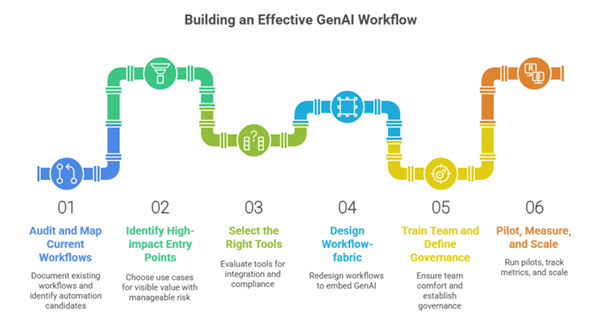
6 Steps to GenAI Workflow Automation
Step 1: Audit and Map your Current Workflows
Document your existing marketing workflows, including content creation, campaign build, approval loops, personalization, and reporting.
Identify repetitive steps, bottlenecks, and high-volume tasks—these are prime candidates for automation.
Step 2: Identify High-impact Entry Points
Choose use cases where embedding GenAI workflow automation can deliver visible value with manageable risk. Examples include generating email subject lines, automating ad copy variants, and personalizing landing pages.
Step 3: Select the Right Tools
Evaluate GenAI workflow tools for fit:
- Do they integrate with your CRM/marketing stack?
- Can they support your brand voice, compliance requirements and scale?
From this research, you will learn that “Not all generative AI tools are created equal. Evaluate tools for their compatibility with your existing platforms and their ability to meet your marketing needs.
Step 4: Design your Workflow-fabric
Redesign your workflow to embed GenAI—not just use it ad-hoc. Define
- roles (who reviews AI outputs),
- steps (prompt → generation → review → deploy),
- quality-checks,
- brand alignment, and
- iteration loops.
Step 5: Train your Team & Define Governance
Your teams must be comfortable designing prompts, reviewing AI-generated content, managing agents (in a GenAI Agentic workflow scenario), and ensuring brand consistency & compliance.
Also define governance: who owns the AI output, escalation paths, revision protocols, and brand voice guidelines.
Step 6: Pilot, Measure & Scale
Run pilot projects, track metrics (time-savings, content volume, engagement lift & error reduction).
Use these insights to refine prompts, workflows and tool integrations. With evidence in hand, scale across the marketing team. It’s a step-by-step process, and if your brand or the marketing agency does it right, no one can stop you from becoming the best in your niche come 2026.
Conclusion
Marketing teams should embed GenAI workflows—not as experiments, but as core tools.
With the right automation, tools, and human-in-the-loop governance, GenAI augments creativity, enabling teams to work smarter, shift from execution to strategy, and stay ahead of competitors by embedding AI with intention & scale.
Wildnet Technologies makes GenAI workflows easier for brands through its 19+ years of marketing experience, 4,100+ clients’ niche expertise, and unquenchable thirst for improvement.
If You like to read,
- Case Study | 334.25% Sales & 89,000+ Organic Traffic Growth | D2C Fashion
- Glossary (Saving the effort to Google)
Connect with us now at info[@]wildnettechnologies.com and witness GenAI in marketing.
FAQs
Question 1. What are GenAI workflows?
Answer 1: GenAI workflows refer to marketing operations that incorporate generative AI models (text, image, video) within defined workflow steps. Such as content creation, personalization, campaign generation—so that AI becomes part of the day-to-day process rather than an occasional tool.
Question 2. What is GenAI workflow automation?
Answer 2: The GenAI workflow automation process automates parts of a marketing workflow using generative AI. For example, generating email variants, scripting A/B Tests, personalizing landing-page copy, or automating campaign logic steps—all leveraging generative AI.
Question 3. What are some GenAI workflow tools?
Answer 3: Many tools are emerging. For example,
- solutions that integrate generative AI with marketing automation and CRM platforms, or
- purpose-built applications for content generation, imagery, personalization and scheduling.
When selecting these tools, integration and brand governance matter the most.
Question 4. What is a GenAI Agentic workflow?
Answer 4: A GenAI Agentic workflow goes beyond single-task AI use.
It envisions AI agents autonomously executing workflow segments—ideation, generation, deployment or optimization—often with minimal human intervention and human oversight for quality & brand alignment.
For example, marketing teams exploring AI agents for segmentation, email drafting or campaign reporting.
Question 5. What are the risks of embedding GenAI workflows?
Answer 5: Risks include,
- brand-voice drift,
- quality or compliance issues,
- fragmented tool adoption (if AI remains siloed),
- lack of human oversight,
- ecosystem integration challenges, and
- potential over-dependence on AI without strategic controls.
To mitigate risk, workflows must be redesigned thoughtfully for GenAI, with governance, measurement and training in place.
You can make it simple and choose us.
